This incredible Vegan French Toast is about to change your weekend brunch game! Fluffy in the middle, crispy on the outside, and rich and buttery throughout, it’s as indulgent as classic French toast!
Lightly toasted bread slices are coated in a rich, subtly sweet, and generously spiced batter before they’re pan-fried until crispy, gorgeously golden brown, and caramelized. Hello, vegan brunch of your dreams.
Yes, this eggless French toast recipe will remind you of what you’d be served at a gourmet brunch spot, but it’s surprisingly easy to make. The batter comes together quickly in a blender, and the slices cook up within a few minutes. Grab a few everyday ingredients and a few thick slices of bread, and you’re good to go!
Table of contents:
1. Why this recipe works
2. Ingredient notes
3. Step-by-step instructions
4. Tips for making this recipe
5. Frequently Asked Questions
6. Recipe card with notes
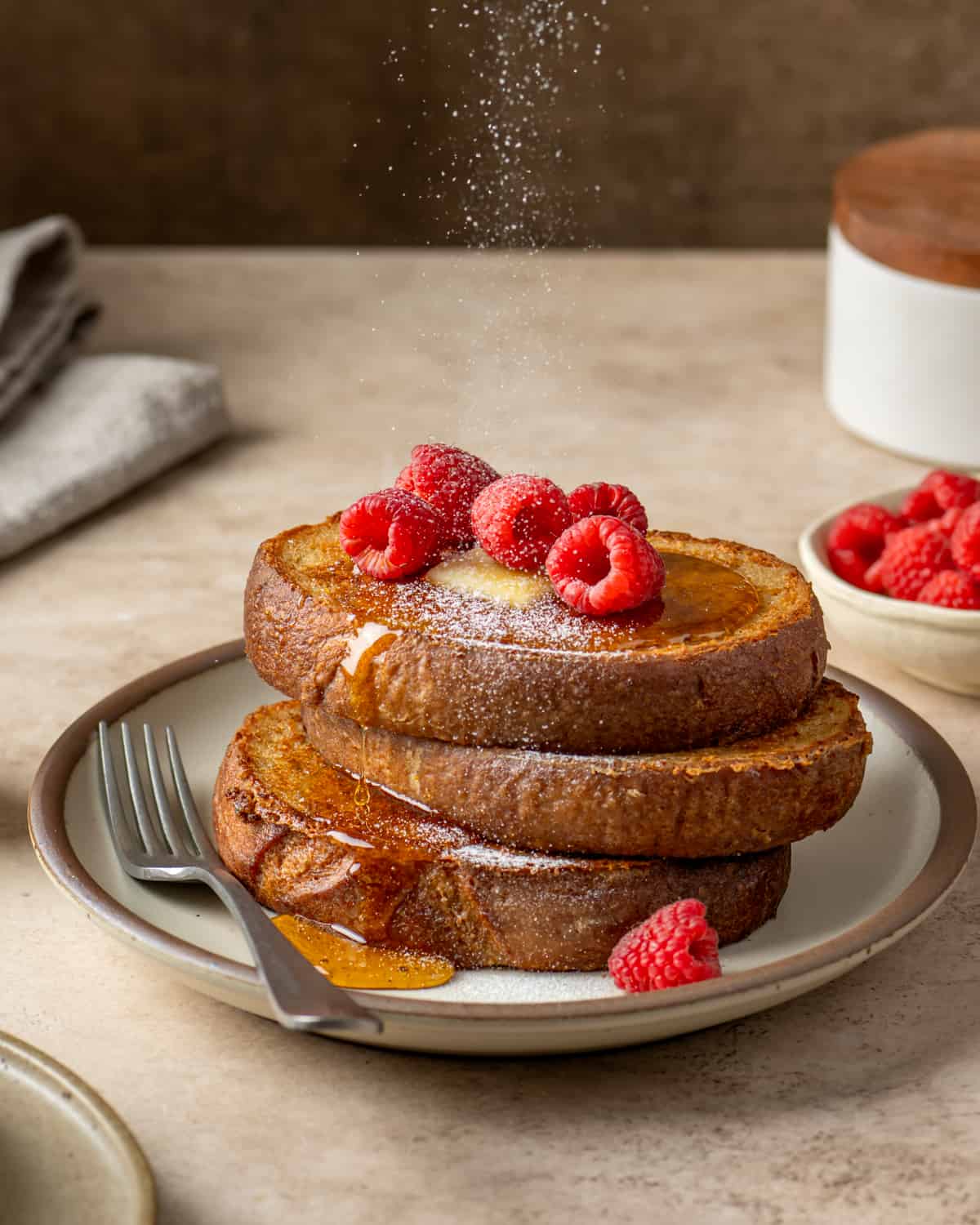
Why this recipe works
It’s all about the food science
When I try to veganize a classic dish, whether it’s French toast, pancakes, brownies, chili, or scrambled eggs, I want to be as faithful to the end result as possible. After all, it’s the best way to truly satisfy cravings (and nostalgia) and to demonstrate that you don’t have to make sacrifices just because you’re vegan.
Because French toast is notoriously hard to veganize (the classic version uses lots of eggs, whole milk or heavy cream, butter, and egg-rich bread), I had to rely on some serious food science for this recipe.
I researched dozens of popular classic French toast recipes and calculated the ratio of fat and protein in the batters so that I could figure out the best vegan substitutes for eggs and milk, half and half, or heavy cream.
With my lab coat apron on, I discovered that using a combination of silken tofu, soy milk, and vegan butter yields a very similar ratio of protein and fat.
Eureka! We discovered the recipe for an egg and dairy-free French toast that will knock your socks off.
The absolute best flavors
Most French toast recipes are pretty simple, with just some sugar and cinnamon flavors. Y’all know I like to take flavor up a notch, so to make things a bit more interesting, I added a few bonus flavors that really make the batter stand out: (1) Freshly grated nutmeg, (2) vanilla extract, and (3) orange zest (my favorite addition!).
Throughout testing, I noticed that while the batter was tasty, it wasn’t as eggy as a “regular” French toast recipe would be. So, I kicked it up a notch with my friend, kala namak (AKA black salt). If you’ve ever made my Tofu Scramble or Vegan Egg Salad recipes, then you know the magic of this simple ingredient! Just a pinch imparts a realistic eggy flavor and aroma to the French toast batter.
Okay, and the textures, too!
When I’m eating dairy-free French toast, I want it to be eggy and fluffy on the inside and slightly crispy and caramelized on the outside. Most importantly, it HAS to be soft but not soggy.
For that perfect fluffiness, I turned to silken tofu + arrowroot powder (or cornstarch). They make a pretty creamy and not-too-thin batter, which is a common problem in a lot of other egg-free batters. With their help, the vegan custard clings to the toast as soon as it hits the hot pan!
Finally, a generous amount of brown sugar is key for the ultimate caramelization. The sugar reacts with the protein from the soy milk and tofu in the hot pan to form a gorgeously golden brown, caramelized crust around each slice of French toast (this is what’s known as the Maillard reaction).
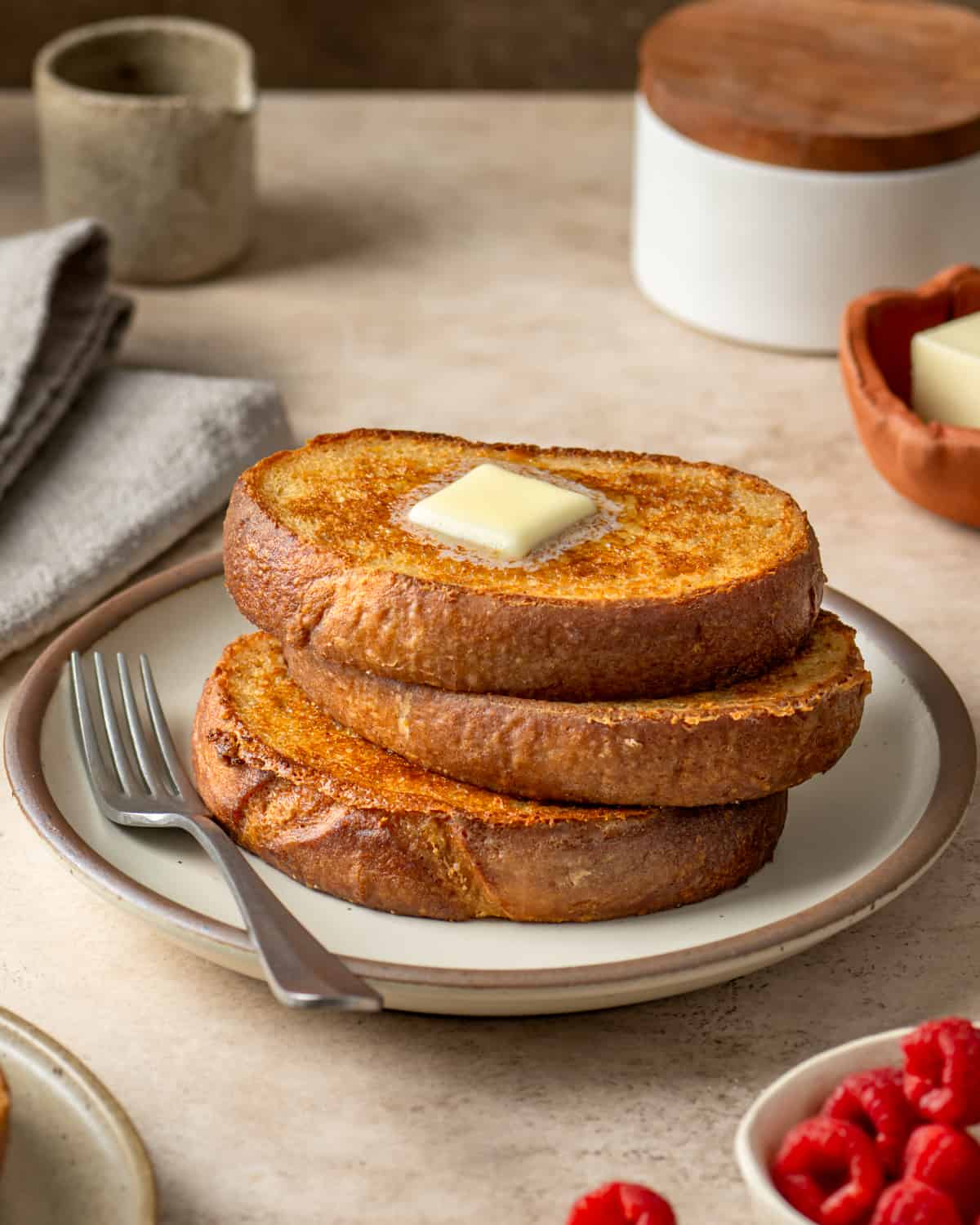
Ingredient notes
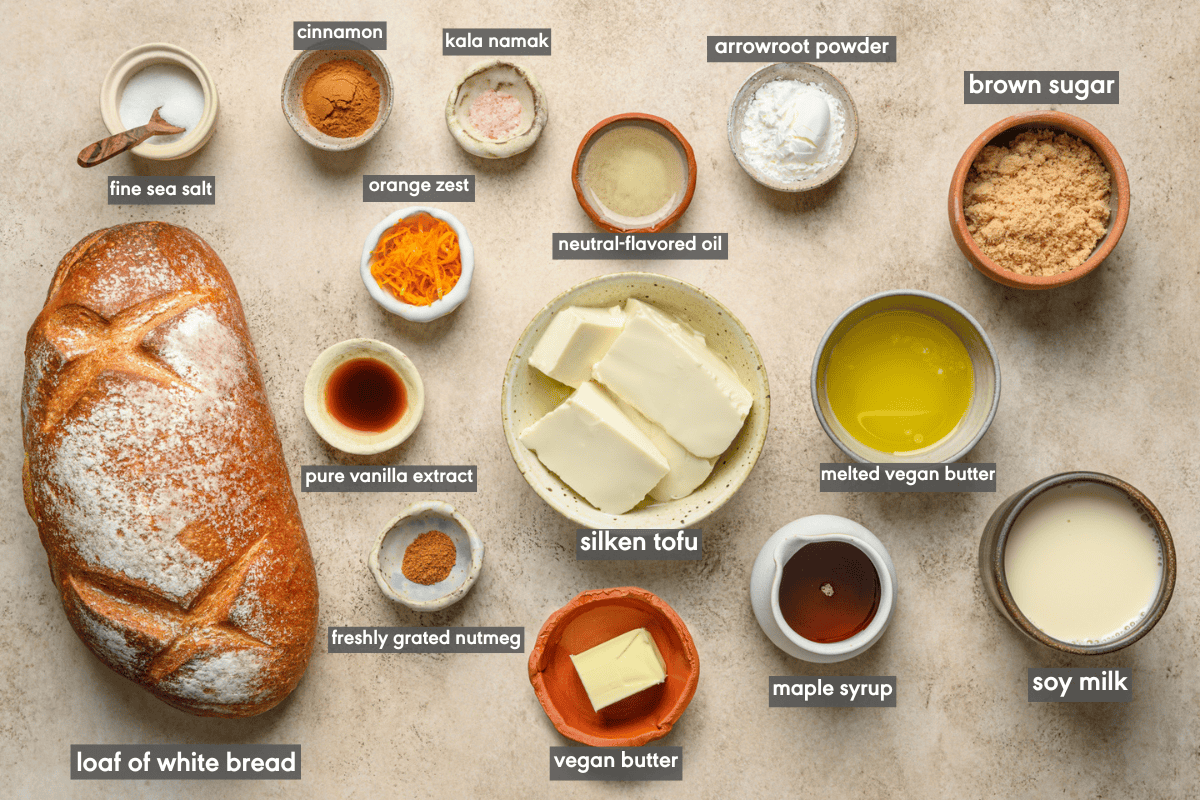
Thick-sliced bread
Bread is obviously the most important ingredient in French toast. After all, French toast was invented as a way for medieval Europeans to use up stale bread.
But using just any type of bread is a recipe for disappointment. Please read this section so you can pick the best bread options for your vegan French toast.
The best bread for vegan French toast is EITHER (1) a sturdy but soft loaf of freshly baked bakery-style bread OR (2) thick-cut white sandwich bread.
Fresh vs. stale bread: You may be surprised to learn that you’ll get better results making French toast with fresh bread that’s been lightly toasted and dried out rather than day-old or stale bread. The former soaks up the batter better, ensuring a rich, soft interior that’s not dry.
Option 1: Fresh bakery-style bread
Pick up a sturdy but soft white loaf from your local bakery or the bakery section of the grocery store. Something like a country loaf, Italian bread, or “pain paesano”.
We found that a loaf of French bread worked pretty well, though the crust does get a little chewy. One our testers enjoyed this with Costco’s Kirkland signature country French bread, so that’s a good option to try. If you have sensitive teeth, you’ll want to remove the crust first.
Do NOT use very crusty bread. For instance, avoid sourdough (it gets too chewy and hard, plus the flavor is too tangy) and bread with big holes or bubbles (e.g., focaccia gets thin and wet).
Option 2: Thick-cut white sandwich bread
Use thick-cut white sandwich bread. Standard sandwich bread is sliced too thin and will make your French toast soggy. The ideal thickness here is 3/4 inch (2 cm), but we also had good results with 5/8 inch (1.5 cm) slices.
We tested this recipe with three types of vegan-friendly soft white sandwich bread:
- Sara Lee Artesano bakery bread (¾” thick)
- Nature’s Own Thick Sliced White bread (¾” thick)
- Maier’s Italian-style bread (⅝” thick)
If you can find vegan-friendly “Texas toast” sandwich bread, that should work well, as those are typically double the thickness of standard slices.
The type of bread you use will determine (1) how to best dry out the bread and (2) how long to soak the bread in the batter.
Check out the Tips section or skip to the recipe card to get the details!
Silken tofu
What can’t tofu do? It’s a magically versatile vegan protein you can fry, bake, or braise for a fantastic meat substitute; you can blend it into a smoothie; use it to make a realistic vegan feta cheese; use it to make gourmet-style desserts; and so. much. more.
New to using tofu? Explore The Complete Guide to Cooking Tofu to discover how amazing this simple ingredient can be!
In this recipe, silken tofu is blended in the French toast batter, making the batter thick, smooth, and creamy. Its natural proteins prevent the batter from spreading in the pan and help it cling to the bread, mimicking the classic creamy egginess of a real French toast custard.
Soy milk
Oat milk is my usual go-to for baked goods but here, I specifically chose soy milk for its high protein content.
The combo of soy milk, tofu, and vegan butter helps mimic the ideal protein and fat content in traditional French toast batter, yielding a I can’t believe this is vegan-style of French toast.
Substitute: If you can’t get your hands on soy milk for whatever reason, you can probably use oat milk with good results. Just make sure the brand you use is creamy and thick, as any sort of thinner, less fatty plant milk will make the batter thin.
Vegan butter
If you want your vegan French toast to taste like the classic version made with lots of rich dairy and eggs, then it has to be fried in a pan with some melted vegan butter. You get excellent buttery flavor and richness in every bite.
Brown sugar
I used brown sugar instead of white sugar because it has a richer depth of flavor. It’s also responsible for the gorgeous caramelization around the edges of the bread. Once the sugar melts in the hot pan, it forms a slightly crispy, crunchy layer around the toast slices.
Orange zest
My secret but not-so-secret ingredient for well-flavored and sweet breakfasty foods like French toast and my Vegan Pumpkin Sheet Pancakes. Just a pinch of orange zest brightens up the batter and adds subtle but complementary floral and sweet flavors. It kind of just sits in the background but still makes you think, “Now THIS is a special French toast.”
Kala namak
Eggs play a huge role in classic French toast, both in texture and flavor. We already locked in the dreamy custard-like textures from the blended tofu and soy milk, but to emulate the flavors, a dash of kala namak, AKA Indian black salt, helps.
It’s naturally very eggy-tasting and just a small amount of kala namak makes this vegan version taste like the real deal. If eggy French toast is not your thing, feel free to skip it.
Where to buy: You can buy black salt from Indian grocers, South Asian grocery stores, or online (affiliate link).
Arrowroot powder or cornstarch
Eggs also help bind and thicken French toast batter. Luckily, starches like arrowroot powder and cornstarch do a good job at both.
Arrowroot powder is usually my go-to but cornstarch works just as well (and is sometimes more accessible).
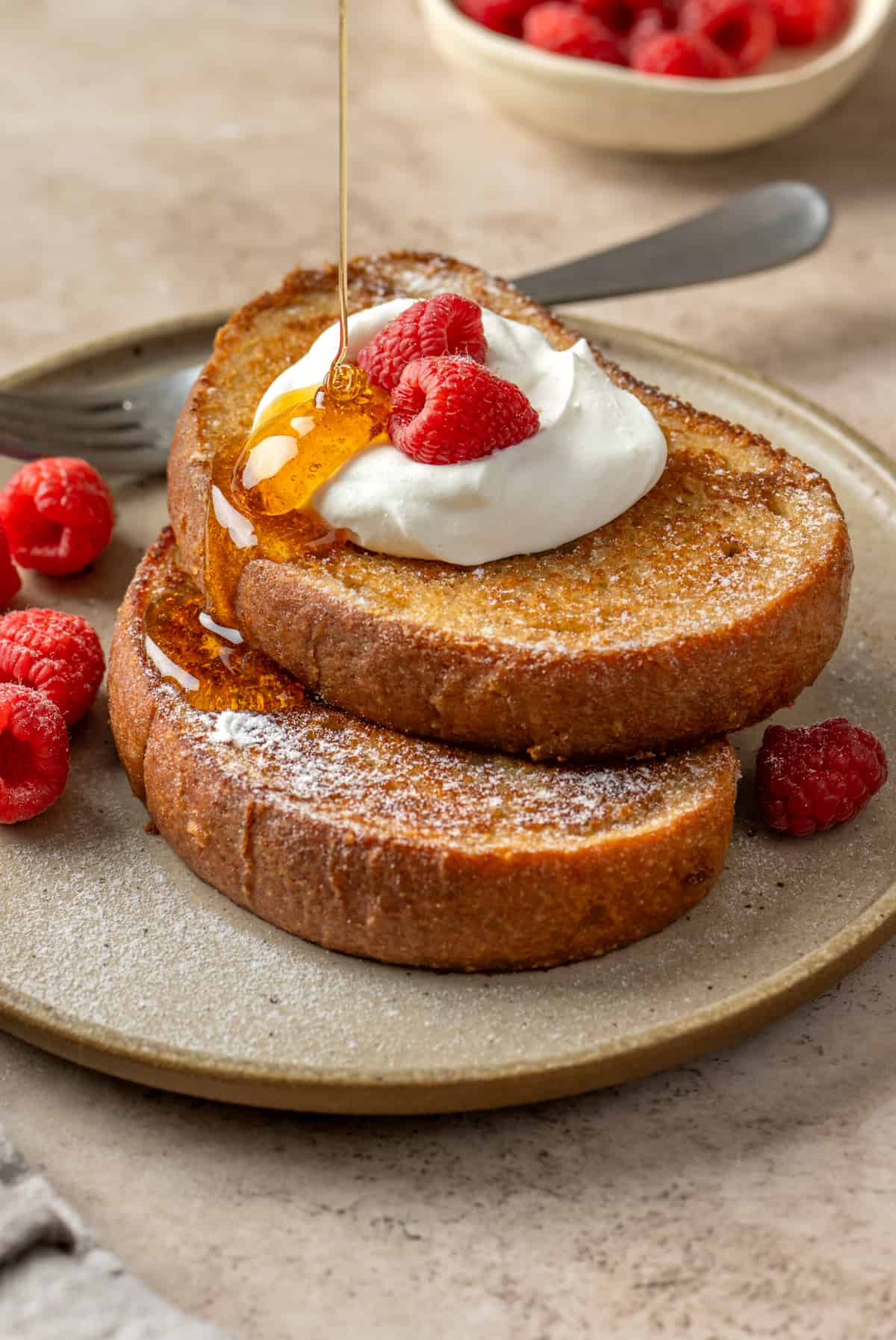
Step-by-step instructions
First, lay the slices of fresh bakery bread OR sliced sandwich bread on a wire rack on top of a baking sheet. Toast in the oven until the slices feel lightly toasted and the middles are slightly moist but not soft or squishy.
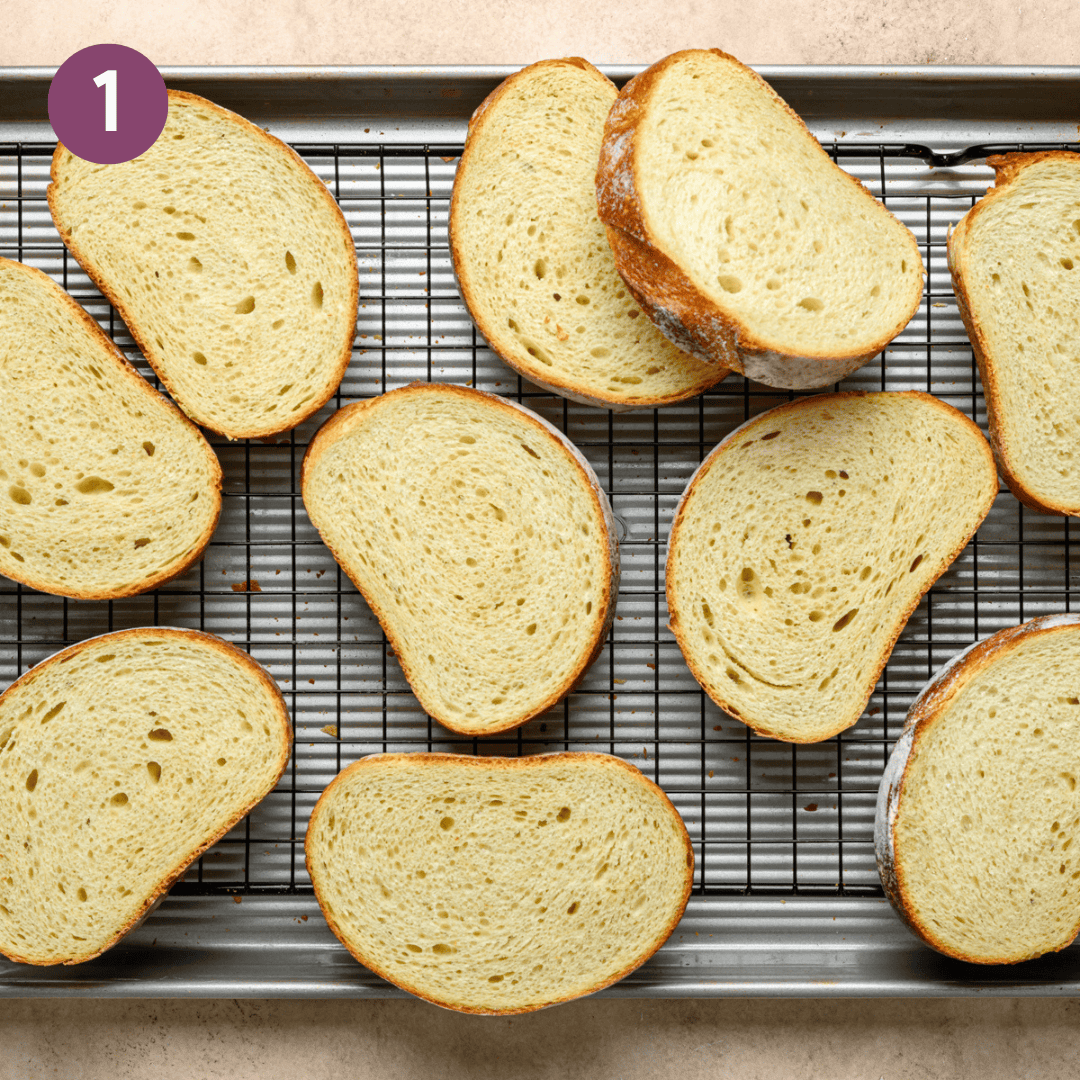
Meanwhile, make the batter by blending the tofu, soy milk, melted butter, sugar, cinnamon, nutmeg, vanilla, salt, and orange zest in a blender or food processor until smooth.
Taste the batter and add more nutmeg, cinnamon, salt, or orange zest as needed. To finish, blend in the kala namak and arrowroot powder (if using) until they’re well incorporated.
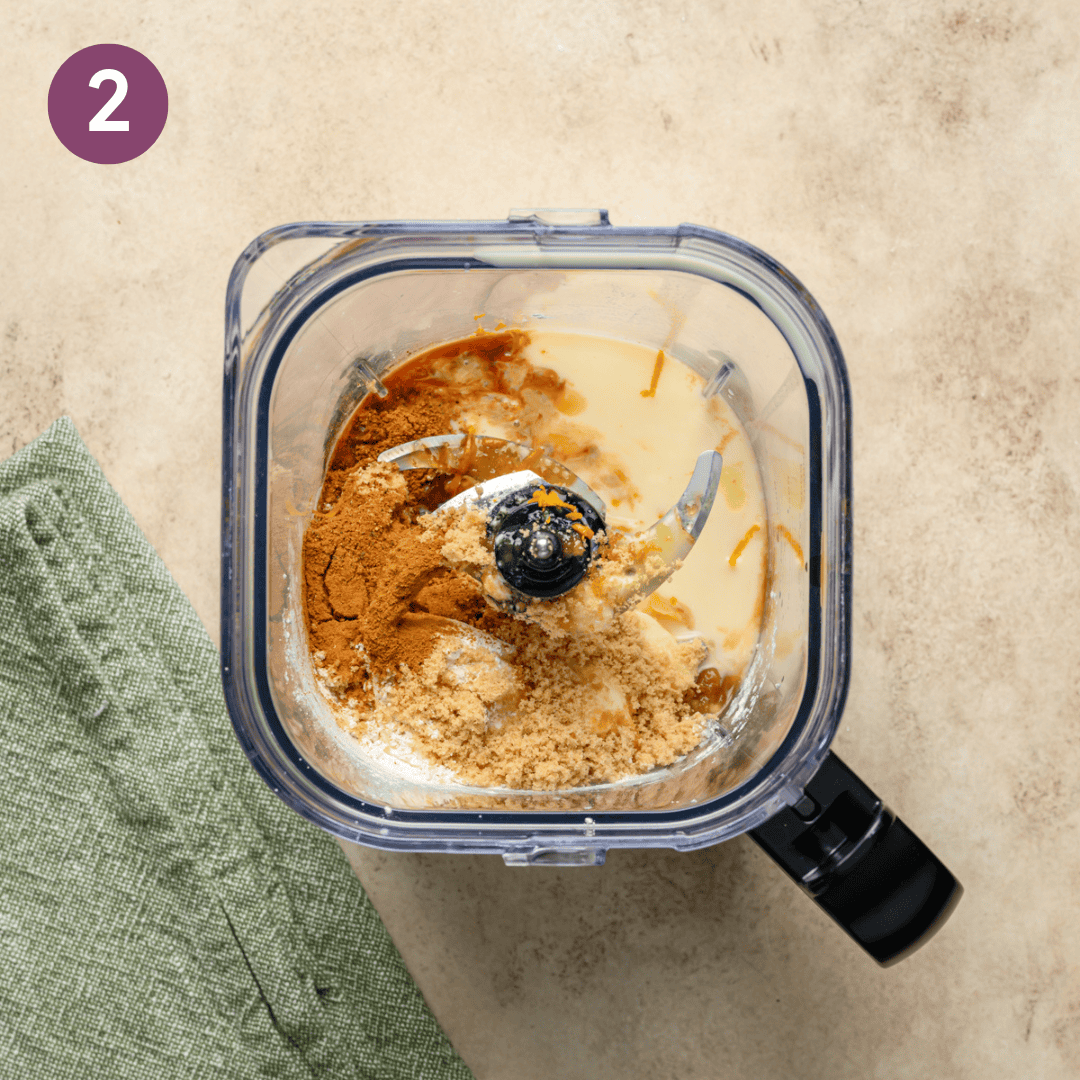
Pour the batter into a 2-liter (9×9″ or 8×8″) baking pan.
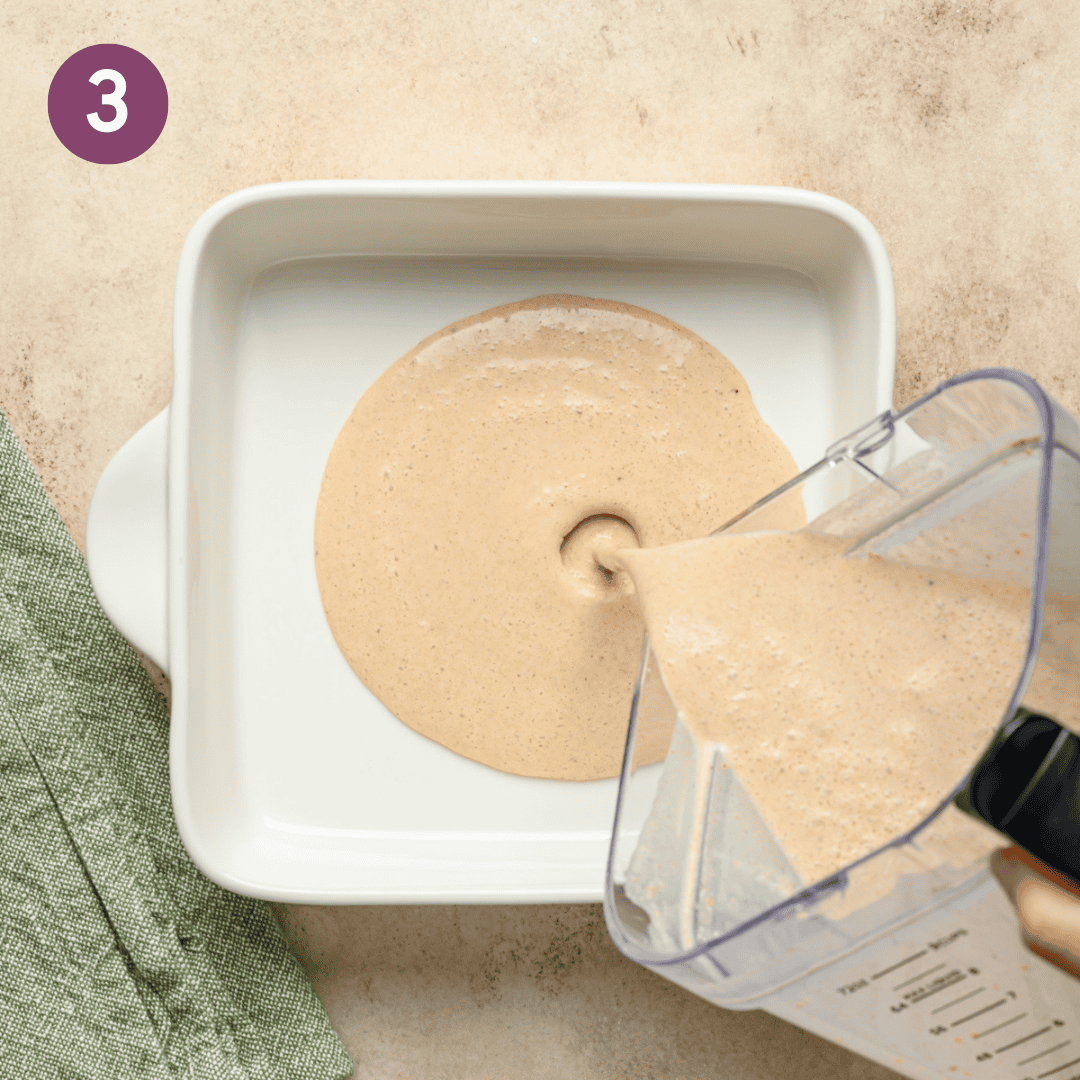
Heat some vegan butter and oil in a large nonstick skillet over medium heat. Once the pan is almost hot and the butter stops foaming, add two slices of bread to the pan with the batter. Swirl them around but don’t dunk them.
- Using bakery bread OR ¾-inch sandwich bread slices? Soak for 30 seconds, then flip and soak for another 30 seconds (the bread should be saturated but not falling apart).
- Using sandwich bread slices thinner than ¾-inches? Soak for 20 seconds, then flip and soak for another 20 seconds (the bread should be saturated but not falling apart).
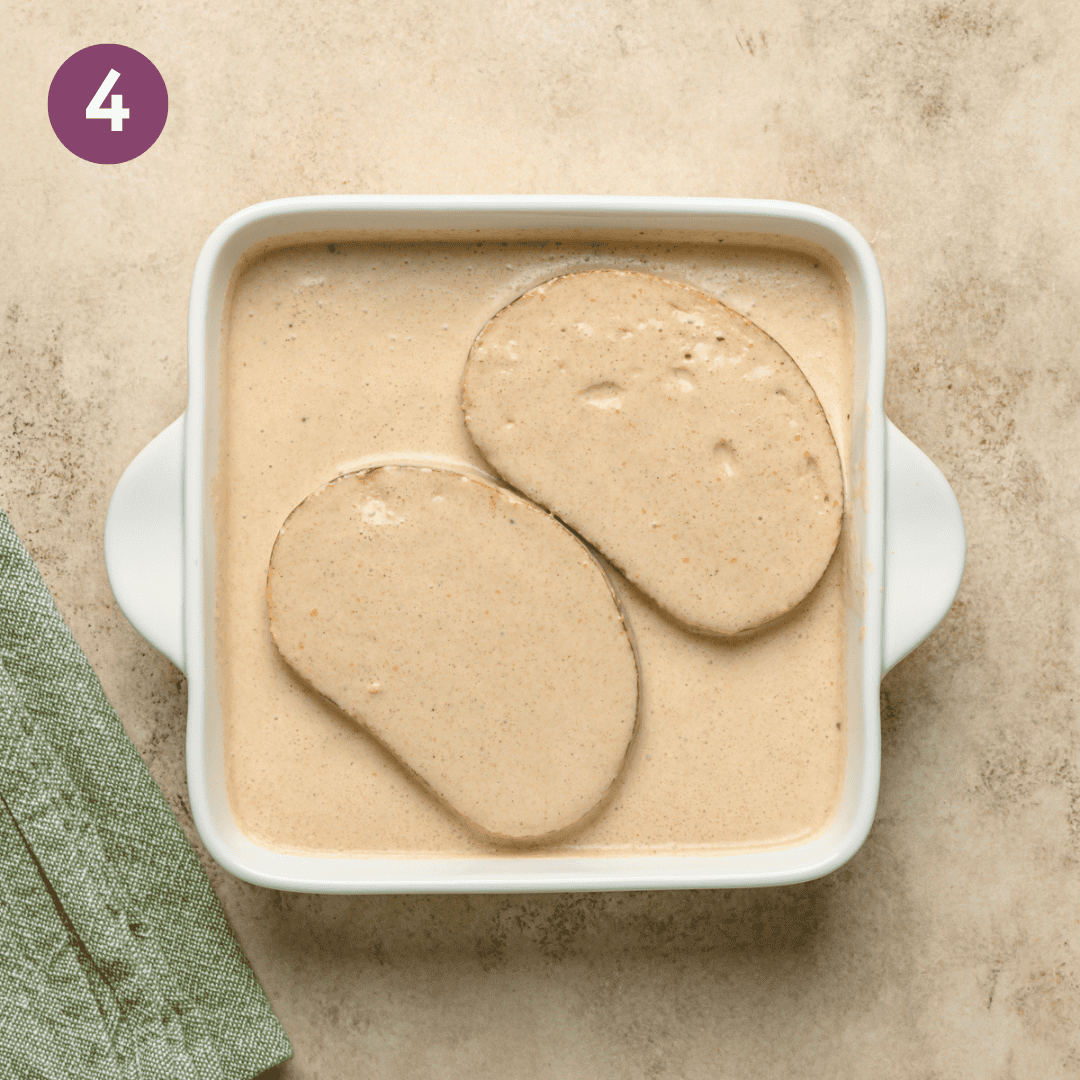
Transfer the slices to the hot pan. Don’t push them around, but swirl the pan occasionally so the butter/oil soaks into the bottom of the bread.
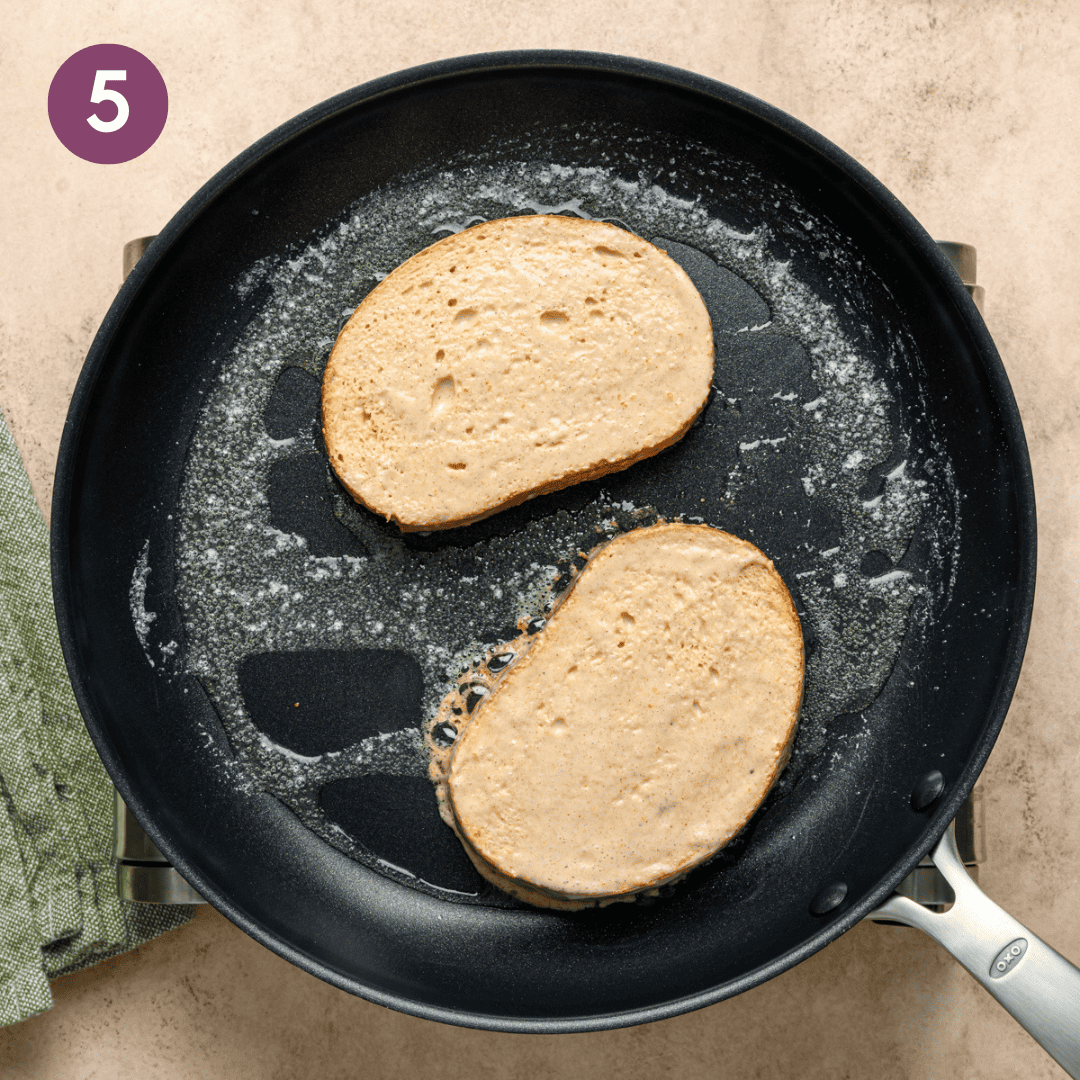
Once golden brown on the bottom, flip and cook until the second side is golden brown.
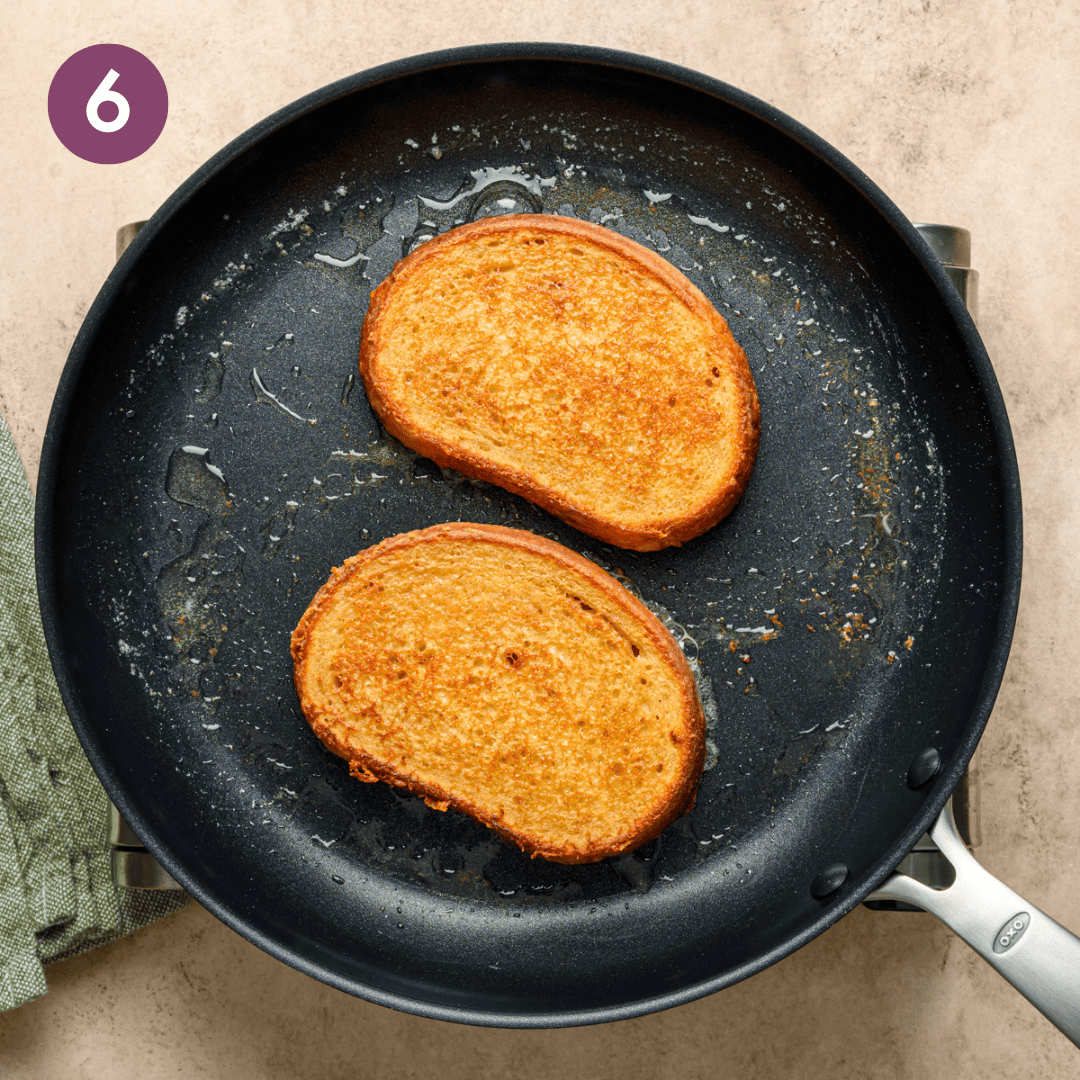
Transfer the cooked French toast to a sheet pan in the oven to stay warm. Repeat until you run out of batter or sliced bread, adding a little more butter/oil to the pan each time.
Serve warm with a pat of vegan butter and maple syrup on top, or berries and whipped topping. Enjoy!
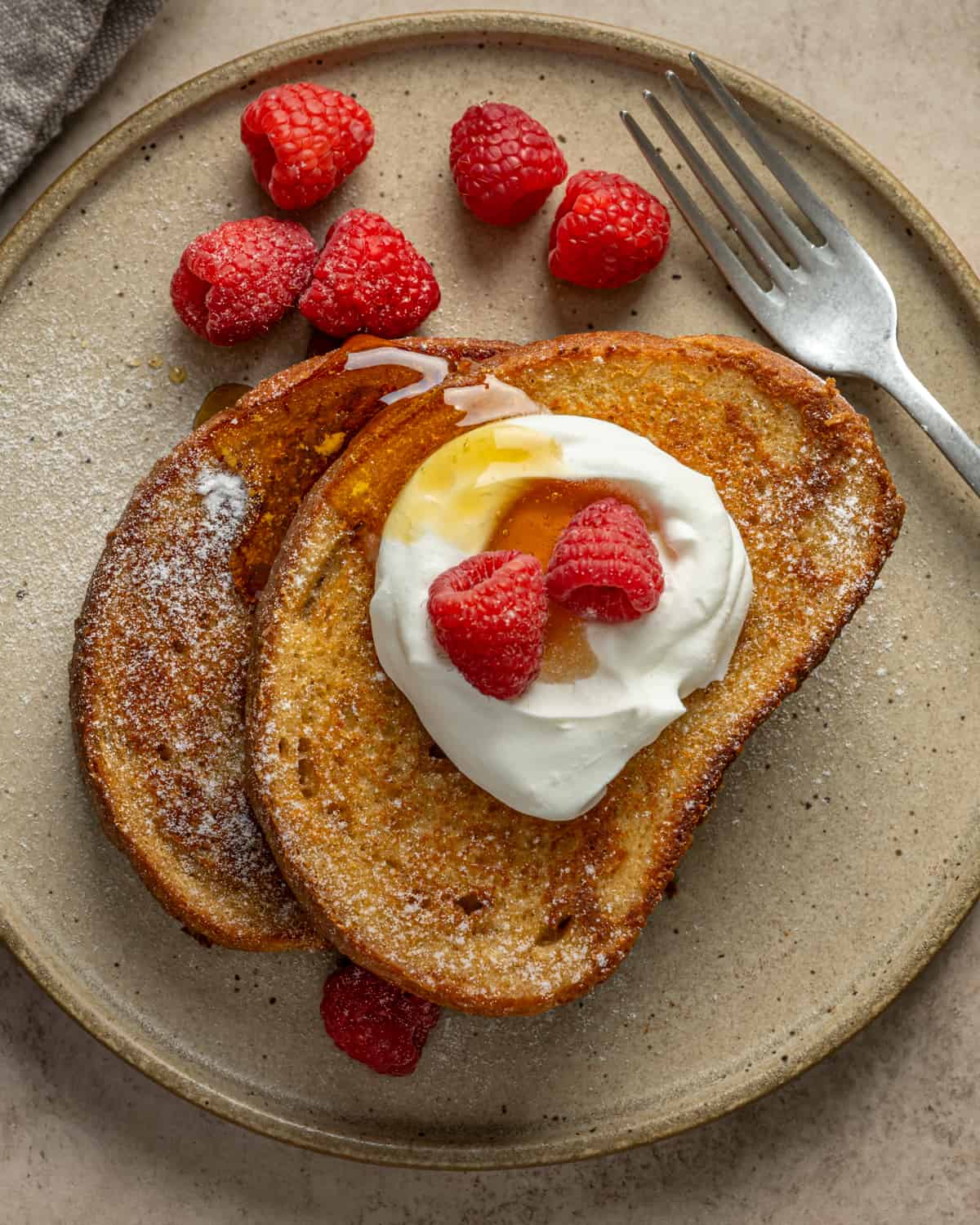
Tips for making this recipe
Use one of the recommended types of bread!
It’s crucial to make vegan French toast with a sturdy but soft loaf of freshly baked bakery-style bread OR thick-cut white sandwich bread.
Prefer a more grown-up, sophisticated French Toast? Use a sturdy but soft loaf of freshly baked bakery-style bread.
Or, if you’re craving the diner-style French toast of your childhood, go for THICK, pre-sliced sandwich bread.
During testing, we found that the ideal breads are soft and have a close-knit, tight crumb, as they soak up the batter the best. We liked using a sturdy but soft white loaf of French bread (the crust got a bit chewy but it was still good).
Do not use sourdough, focaccia, or any other type of crusty bread with large holes or bubbles.
Head back to the Ingredient Notes for our recommended brands of sandwich bread.
Dry out your bread first
Fresh bread will give you soggy results. Lightly toasting the bread slices beforehand, however, helps the slices soak up the perfect amount of batter so the bread is fluffy on the inside yet crispy on the outside.
The type of bread you use will determine the amount of time and temperature at which you dry out the bread.
Using freshly baked bakery-style bread? Place it in a 250ºF/120ºC oven for 6 minutes, then flip and bake for another 4 minutes.
Using pre-sliced sandwich bread? Place it in a 300ºF/150ºC for 8 minutes, then flip and bake for another 6 minutes.
These are the times that worked for me and my recipe tester, but all breads vary, so keep these visual cues in mind:
- The bread should feel lightly toasted.
- The center should be slightly moist but not soft or squishy.
- If it’s super hard and crusty, the bread won’t soak up the batter as well.
Give your bread a good soak
Similarly, the type of bread you use will also determine the amount of time it should soak in the batter.
Using freshly baked bread OR sandwich bread that’s ¾-inch (2 cm) or thicker? Soak the bread in the batter for 60 seconds, turning halfway through.
Using sandwich bread that’s THINNER than ¾-inch (1.5 cm)? Soak the bread in the batter for 40 seconds, turning halfway through.
According to America’s Test Kitchen, French toast should be soft but still have a thin layer of unsoaked bread in the middle (called the “bone”). This contributes to the structure of the French toast, lending a custardy but not soggy texture.
In our tests, the above-listed soak times resulted in the ideal texture: an eggy, soft interior that still had just enough structure and “bone” and wasn’t soggy.
Note: We spent lots of time testing this recipe but keep in mind that there is so much variety in bread types as well as soy milk, so things may work differently for you. For instance, if your first French toast comes out soggy, reduce the soaking time for the next slices.
Taste the batter
Don’t add the kala namak or arrowroot powder to the batter at first. Instead, taste the batter after the first round of blending to determine if it needs any more salt, cinnamon, sugar, etc. without the strong eggy aroma or chalkiness of cornstarch/arrowroot powder interfering.
Fry in half butter, half oil
Classic French toast and pancake recipes are often cooked in a mix of butter and oil, not one or the other. The milk solids in butter burn too easily and oil doesn’t contribute as much flavor as butter.
Even though vegan butter doesn’t contain milk solids, it still burned more easily during our tests. That’s why I like to cook French toast with 50% vegan butter and 50% high-heat neutral flavored oil, like avocado oil or grapeseed oil.
Always preheat the pan and adjust the heat
First, give the pan some time to warm up, about 3 minutes. Pay a careful eye as the French toast is cooking; if it’s cooking too quickly, lower the heat.
I like to start at medium heat, and after the second batch, lower the heat to somewhere between medium and medium-low.
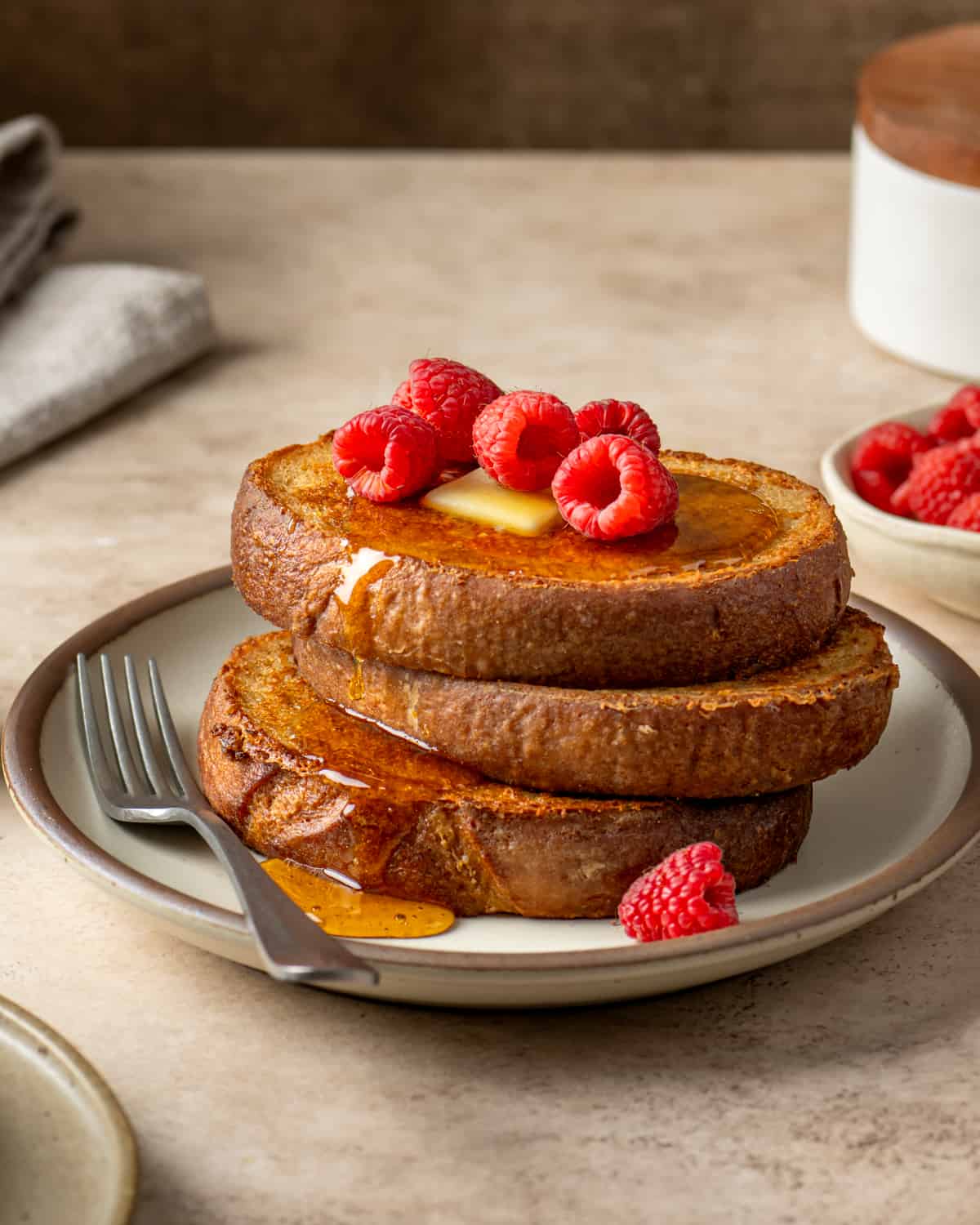
Frequently Asked Questions
So far, I don’t have a substitute for silken tofu, but I suspect soft tofu would work just fine instead.
It’s also possible that a liquid vegan egg substitute like JUST Egg would be great but I haven’t tested it to know the ratios.
The type of bread you use, the toasting time, and the soaking time will all affect the texture of the French toast. If you want to avoid soggy French toast, stick to our bread recommendations and adjust the toasting and soaking times based on what you’re using. Scroll to the Tips section or the recipe card for the details.
Sure! Reheating French toast on the stove is best for a crispy but custardy texture, but the oven works well, too.
To reheat on the stove, heat a frying pan over medium heat with a bit of vegan butter or neutral-flavored oil. Once hot, add a slice or two of leftover French toast. Heat for 1 to 2 minutes on both sides. For a crispier exterior, increase the heat to medium-high and briefly reheat.
To reheat in the oven, place the French toast on a wire rack fitted on a sheet pan and cover with foil. Heat in a 350ºF/175ºC oven for 8 to 10 minutes. If you want a crispier exterior, take the foil off during the last few minutes.
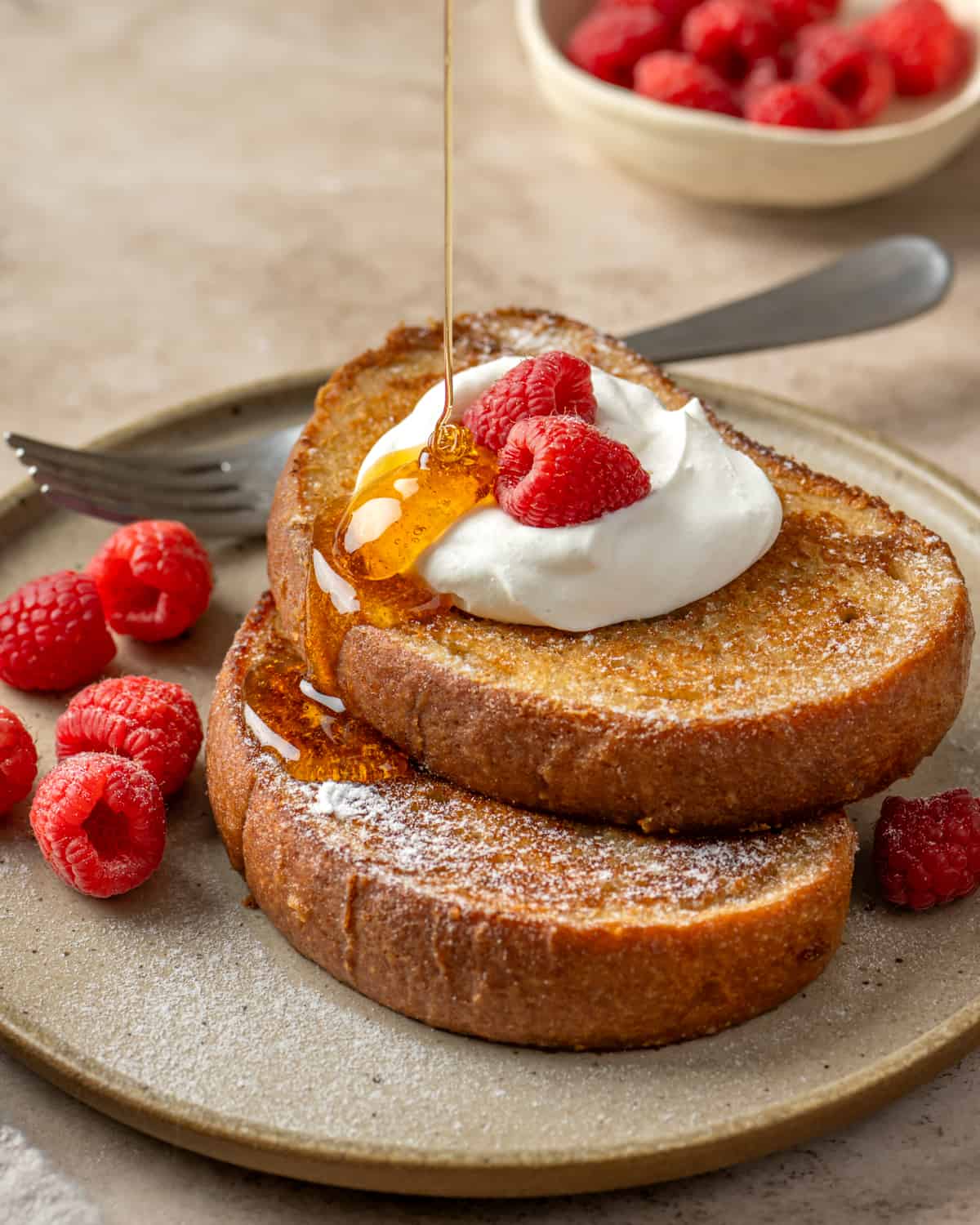
More nostalgic breakfast favorites
If you give this Vegan French Toast a try, be sure to tag me on Instagram with your recreations and please comment with your feedback below!
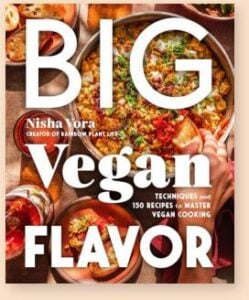
Big Vegan Flavor
Techniques and 150 recipes to master vegan cooking.
Vegan French Toast
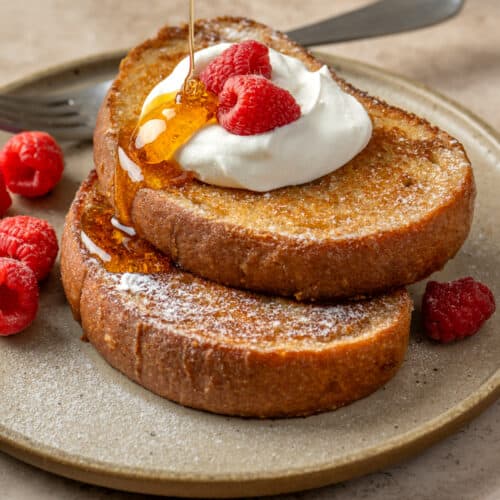
Ingredients
Bread (pick ONE)
- 1 (10-inch/18 to 20 oz ) loaf freshly baked soft white bread (not crusty or hard, see Note 2)
- 10 to 12 slices THICK-CUT white sandwich bread (¾” thick) (see Note 3)
Batter
- 12 ounces (340g) silken tofu, drained
- 1 ½ cups (360 mL) unsweetened soy milk
- 2 tablespoons vegan butter, melted
- 5 tablespoons (50 to 55g) organic brown sugar
- 1 ½ to 2 teaspoons ground cinnamon (see Note 4)
- ½ teaspoon freshly grated nutmeg
- 1 ½ teaspoons orange zest (about 1 medium orange)
- 1 ½ teaspoons pure vanilla extract
- ¼ teaspoon fine sea salt, more as needed
- ⅛ teaspoon kala namak (optional, for a subtle eggy flavor)
- 2 ½ tablespoons arrowroot powder (or cornstarch)
For cooking and serving
- 3 to 4 tablespoons vegan butter, plus more for serving
- 3 to 4 tablespoons Neutral-flavored high-heat oil of choice, for cooking
- Pure maple syrup
Instructions
- If using FRESH BAKERY BREAD: Slice the loaf into 1” (2.5 cm) thick slices. With a standard 10-inch loaf weighing 18 to 20 ounces (510-570g), you should get 10 slices.
- Place sliced bakery bread or sandwich bread slices on a wire rack set over a sheet pan. Arrange a rack in the middle of the oven.Bake the bread using the times below, or until the bread feels lightly toasted: the center should be slightly moist but not soft or squishy, not super hard or crusty.
- If using FRESH BAKERY BREAD: Preheat the oven to 250ºF/120ºC. Bake the bread for 6 minutes, then flip and bake for 4 minutes.
- If using THICK SANDWICH BREAD: Preheat the oven to 300ºF/150ºC. Bake for 8 minutes, then flip and bake for 6 minutes.
- Transfer toasted bread to a plate or cutting board; cool 5 minutes. Turn the oven off, or reduce the temp to 200ºF/95ºC and keep the rack-fitted sheet pan handy.
- While the bread toasts, make the batter: In a blender or food processor, combine the tofu, soy milk, melted butter, sugar, cinnamon, nutmeg, orange zest, vanilla, and sea salt. Do not add the kala namak or arrowroot powder yet (so you can taste and adjust). Blend until completely smooth and no lumps remain.Taste, adding more nutmeg, cinnamon, salt, or orange zest as desired. Now add the kala namak, if using, and arrowroot powder. Blend again to incorporate. Note: it will smell eggy from the kala namak!
- Pour the batter into a 9×9”, 8×8”, 7×11”, or similar baking pan (~2 liter baking pan).
- Heat a large nonstick skillet over medium heat with 2 teaspoons of vegan butter and 2 to 3 teaspoons of high-heat oil. Heat for about 3 minutes, swirling the skillet occasionally, until the foaming subsides.
- When the pan is almost done heating up, add two slices of bread to the batter. Use your hands to swirl the bread around in the batter but don’t completely dunk them.a. Fresh bakery bread AND ¾” (2 cm) sandwich bread slices: Soak for 30 seconds on one side, then turn and soak the second side for 30 seconds, or until saturated but not falling apart. 60 seconds total. b. Sandwich bread slices thinner than ¾”: Soak for 20 seconds on one side, then turn and soak the second side for 20 seconds, or until saturated but not falling apart. 40 seconds total.
- Use a slotted spatula to transfer battered slices to the hot pan, leaving behind excess batter. Don’t push the bread around in the pan.Cook until golden brown on the bottom, 3 to 4 minutes, swirling the pan occasionally so the butter/oil soaks into the bottom of the bread.When golden brown on the bottom, flip. Cook until the second side is golden brown, 3 to 4 minutes. If you can push down on the center of the toast and see liquid squeezing out, it's not done yet.NOTE: If the toast is cooking too quickly, reduce the heat to medium-low. After the second batch, I typically reduce the heat to somewhere between medium and medium-low.
- Transfer cooked French toast to the wire rack-fitted pan in the oven to stay warm. Wipe the pan between batches to ensure the butter doesn’t burn. Repeat with the remaining slices, adding more butter/oil to have a light coating in the pan.
- Serve French toast warm with a pat of vegan butter, if desired, and drizzle with maple syrup.
Notes
- There’s a range in cook time because it will vary based on how many slices you cook!
- Don’t use breads that are very crusty (e.g., sourdough) or breads with big holes or bubbles (e.g., focaccia). If your bakery or bakery section has a nice sturdy but soft white loaf (e.g., country loaf, Italian bread, “pain paesano”), that works best. In our tests, a loaf of French bread worked pretty well, but the crust gets a bit chewy.
- This recipe also works great with pre-sliced white sandwich bread but only if it’s thick cut, minimum thickness of ⅝” and ideally ¾” thick (1.5 cm, ideally 2 cm). See the Tips section for the brands we tested. Freshly baked bread makes for a more grown up, sophisticated French toast, but if you prefer diner-style French toast, use the pre-sliced sandwich bread.
- I love this with a full 2 teaspoons of cinnamon, but if you don’t love cinnamon as much, use the smaller amount.
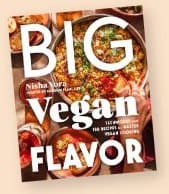



I used Sara Lee Artisano bakery bread and it came out perfect! My husband & I ate the entire loaf within 24 hrs, that’s how good it was! And we even had a little batter leftover. It’s crazy how the orange peel really takes it over the top. For the last batch I made on day 2, I toasted the bread in the toaster instead of the oven and they came out just as good. This is going to be my go-to recipe for a special breakfast on the weekend. Thanks Nisha! U crushed this one, yet again! <3 Cheers from VA :)
This was so delicious! I was looking for one using silken tofu. So tasty!
I am gluten free so used a gluten free brioche bread, only soaked it for seconds as it’s not exactly the sturdiest, but result was sooo good
We appreciate your feedback and support, Ali. Thank you for leaving a review!